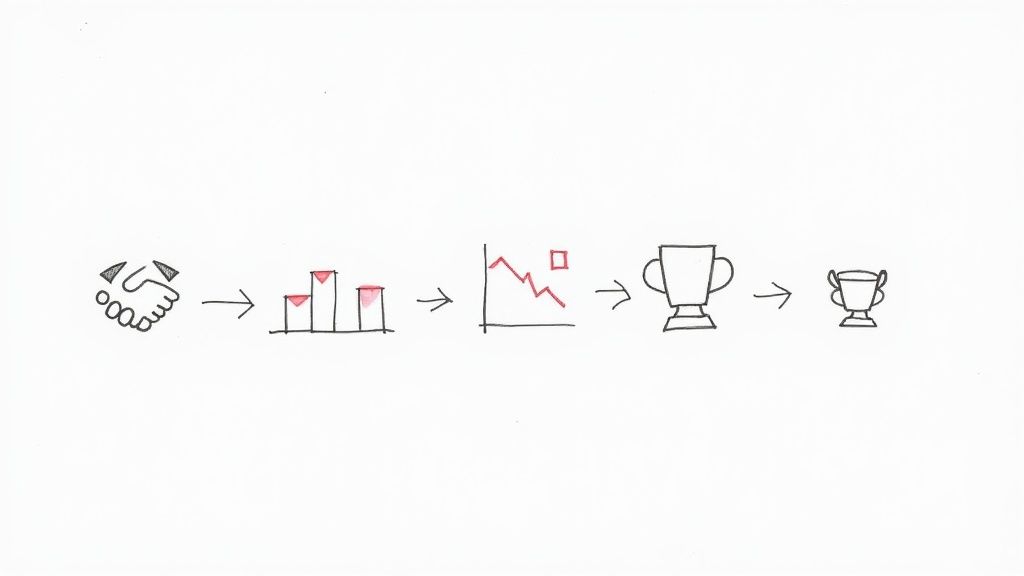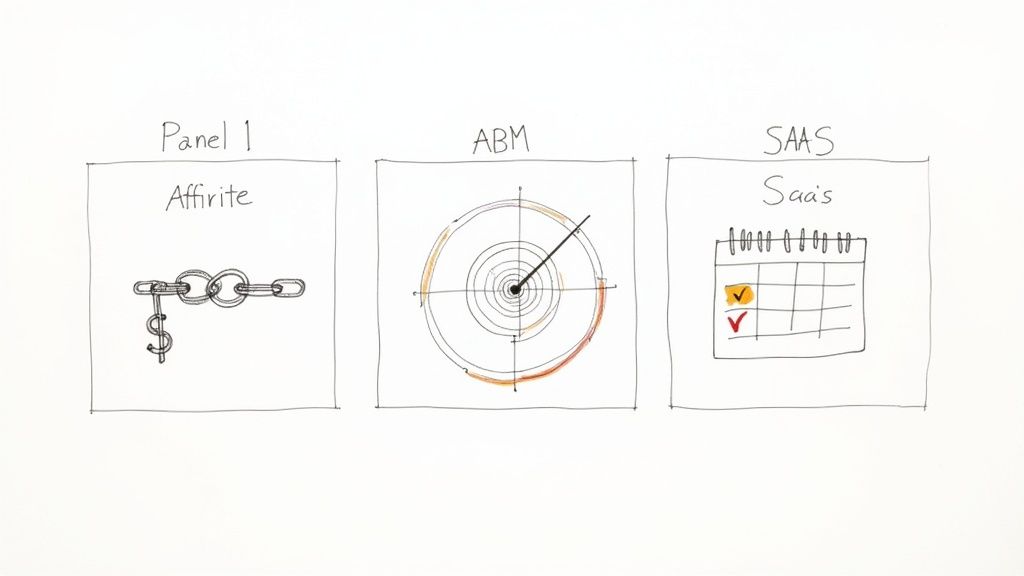
Understanding Ad Fatigue: Causes, Symptoms, and Solutions
Learn what is ad fatigue, its causes, symptoms, and effective solutions to combat it and keep your ad campaigns engaging and performing well.

Think about it this way: you wouldn't pay a builder just for showing up and hammering some nails. You pay them when the house is finished and you can move in. That’s the simple, powerful idea behind outcome-based marketing.
This model flips traditional marketing on its head. Instead of paying for things like clicks or impressions, you pay for the results that actually grow your business—things like qualified leads, new customers, or a direct increase in sales.

At its core, outcome-based marketing is an agreement where payment is tied to achieving specific, pre-defined goals. It’s a clean break from old-school models that often rewarded busywork, regardless of whether that work actually helped the company.
Forget vanity metrics. This strategy is all about focusing on the end-game results that directly affect your bottom line.
It’s easy to get tangled up in marketing activities versus actual business results. This is where the distinction between "outputs" and "outcomes" becomes critical.
Outputs are the things your marketing team does. Outcomes are the measurable impact of those actions.
For instance, publishing four blog posts in a month is an output. Generating 50 qualified leads from those posts? That’s an outcome. Too many marketing teams get stuck chasing outputs, but a true outcome-based approach forces everyone to focus on what really moves the needle.
To help clarify, let's look at a side-by-side comparison.
This table shows the fundamental shift in mindset. You're not just buying marketing services; you're investing in guaranteed business growth.
While this approach has a lot in common with performance marketing, it digs deeper by targeting core business goals that go beyond a simple click or a form fill. You can explore performance marketing in more detail to understand the nuances.
This approach aligns your marketing partner’s incentives directly with your own. When they succeed, you succeed—creating a powerful partnership where everyone is invested in achieving real growth and tangible results.
Ultimately, this shared accountability means every single marketing dollar is spent with the clear purpose of delivering a measurable return.
Switching to an outcome-based model does more than just polish your marketing stats. It completely changes the game by linking your marketing directly to your core business goals. This turns the typical client-vendor dynamic into a genuine partnership where everyone wins together.
Think about it: when you pay for performance, you immediately slash your financial risk. You’re no longer throwing money at campaigns and just hoping they work. Instead, every single dollar is tied to a real, tangible result. This means your budget is laser-focused on what actually moves the needle for your business, not just racking up empty-calorie metrics like impressions or clicks.
This model creates a powerful sense of shared accountability. Your agency isn't just a contractor you hire; they're now a co-owner of your success. Their paycheck is directly tied to hitting the specific outcomes you care about, whether that's delivering sales-ready leads or boosting customer lifetime value.
When goals are aligned like this, some pretty cool things start to happen:
Let’s say you're a B2B company that starts paying your agency for each qualified demo they book. The agency is no longer just chasing any lead; they’re hunting for high-quality prospects who are actually interested. This leads to better sales calls and a much more predictable pipeline.
At the end of the day, this strategic shift makes your marketing a reliable engine for growth. By focusing on outcomes, you stop buying marketing activities and start investing in a system built to deliver measurable, long-term success.
In outcome based marketing, the way we keep score is completely different. Forget about vanity metrics like clicks and impressions. Here, we're laser-focused on results that actually show up on your balance sheet. The entire game shifts from tracking campaign activity to measuring real business impact.
Think of these core metrics as the vital signs for your marketing efforts. They aren't just numbers on a screen; they tell you the financial health of your campaigns and pinpoint exactly what’s driving growth.
By tying every marketing action to a tangible business outcome, you make sure every dollar is spent with a purpose—driving measurable returns instead of just making noise.
To really nail this, you need to track the right Key Performance Indicators (KPIs). Below is a quick rundown of the most essential KPIs you'll want to keep an eye on.
These three metrics don't work in isolation; they weave together a complete story about your marketing performance. For a deeper dive into the final one, our guide on how to measure marketing ROI breaks down the calculation step-by-step.
Getting a clear picture also means using the right tools. To accurately measure how off-platform campaigns drive on-platform sales, mastering something like Amazon Attribution is a must.
This outcome-focused approach is quickly becoming the new standard. And it’s no surprise that technology is leading the charge. In fact, a whopping 83% of sales teams using AI reported revenue growth, a significant jump from the 66% of teams not using it. That statistic really drives home how powerful it is to connect smart technology directly to business results.
Shifting to an AI-driven outcome strategy isn't about flipping a switch; it's about changing your mindset. It starts with defining what success actually looks like for your business. Forget chasing vanity metrics. Are you trying to boost customer lifetime value? Or maybe slash your customer acquisition costs? Get crystal clear on those goals first.
Once you know your destination, AI becomes the high-performance engine that gets you there. AI tools can sift through massive amounts of data to pinpoint your most valuable audiences with a level of precision that was once unimaginable. This means you can create campaigns that speak directly to individuals, leaving generic, one-size-fits-all messaging in the dust.
Personalization is the heart and soul of modern outcome based marketing. Today’s customers don’t just want personalized experiences—they expect them. In fact, a whopping 80% of consumers say they’re more likely to buy from a brand that gets personalization right, according to research from Deloitte Digital.
When you nail this with AI, you create a direct line between your marketing activities and real business growth, from higher revenue to fiercely loyal customers.
Of course, none of this works without a solid tracking and attribution system. You absolutely have to know which touchpoints are doing the heavy lifting and leading to your desired outcomes. The process is straightforward: track what users do, analyze the data to see what's working, and then optimize your campaigns based on those insights.

This constant feedback loop is where AI really shines. The algorithms learn and adjust your campaigns on the fly, making sure you’re always getting the best possible return on your investment. If you're ready to build this kind of system, our guide on crafting an AI-driven marketing strategy is the perfect place to start.
By pairing clear business goals with smart technology, you’re not just running campaigns—you’re building a powerful marketing machine designed to deliver real, tangible results.

Theory is one thing, but seeing how outcome-based marketing works in the wild really brings it to life. Let's look at a few proven models that businesses rely on every single day. These examples show just how you can tie payments directly to real, tangible results.
Probably the most well-known example is affiliate marketing. In this setup, a brand gives a unique link to a content creator or publisher. That affiliate then promotes the brand's products, and instead of getting paid for clicks or views, they earn a commission only when someone makes a purchase through their link. Simple, effective, and 100% results-driven.
Another powerful approach, particularly in the B2B world, is Account-Based Marketing (ABM). Forget casting a wide net and hoping for the best. ABM is more like a sniper than a shotgun—it treats individual, high-value companies as their own unique markets.
Marketing and sales teams work together, crafting hyper-personalized campaigns designed to win over specific target accounts. It’s a focused, collaborative effort.
And it works. As of 2022, more than two-thirds of marketers have an ABM strategy in place, which tells you a lot about its impact on the bottom line. You can dig into more key ABM statistics to see just how popular it's become.
The outcomes in an ABM campaign are tied tightly to the sales process. For example, a SaaS company might work with a marketing partner on a very clear goal:
This way, the partner isn't just churning out useless leads. They’re incentivized to deliver prospects who are actually ready to have a serious conversation. That focus on quality over quantity is what makes outcome-based models so powerful.
Even when the benefits seem clear, switching up your marketing approach can feel like a big leap. It's only natural to have a few questions. Let's tackle some of the most common ones we hear about moving to an outcome-based marketing model.
You bet. In fact, it's often a game-changer for smaller businesses. When you're watching every penny, paying for actual results—like a new customer walking through the door or a solid lead in your inbox—takes a ton of risk off the table.
This model helps you make sure your budget is working as hard as you are. It lets you punch above your weight, competing on efficiency and real ROI instead of just trying to outspend the bigger players.
Making the switch doesn't have to be a massive headache. The very first thing you need to do is get crystal clear on what a valuable "outcome" actually is for your business. Is it a booked demo? A finalized sale? A new subscriber to your service?
Once you know exactly what you're aiming for, you can start building agreements with partners or agencies around those specific goals. A great way to begin is by testing it out with a single campaign. See how it feels before you dive in headfirst.
If you take away one thing, let it be this: The heart of any outcome-based deal is absolute clarity. Before a single dollar is spent, both you and your partner must agree on the exact definition of a successful outcome and how you'll track it. This simple step prevents a world of confusion later on.
Think of it less as a negotiation and more as building a true partnership. It all comes down to transparency and making sure everyone is on the same page. To create a contract that actually works, be sure to nail down these details:
By focusing on these points, you build a fair agreement where your partners are genuinely motivated to bring you the results that truly drive your business forward.
Ready to stop paying for clicks and start investing in customers? BrandBooster.ai is built on outcome-driven marketing that guarantees a return on your ad spend. We blend expert strategy with smart AI to deliver the growth you're looking for.
Learn more about our results-driven approach at BrandBooster.ai